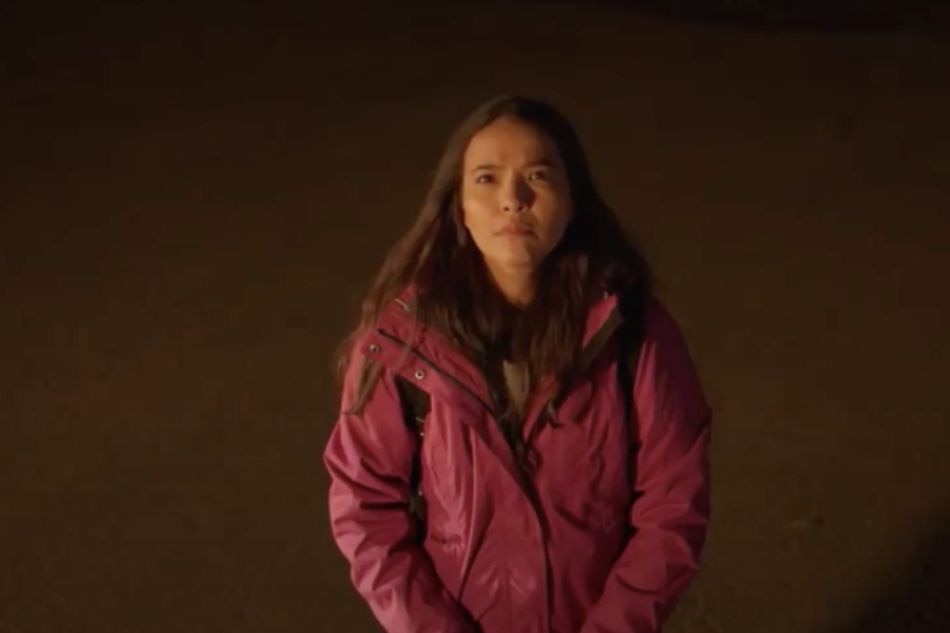They have a name for every type of movie these days. For instance, I hear that they’ve coined a term for movies like Through Night and Day (which is enjoying a period of rebirth as people discover it on Netflix, after giving it the cold shoulder when it was first theatrically released in November 2018): “indie feels”—that sub-genus of romantic movies featuring guerrilla-style, prudently financed filmmaking that deal with two characters dissecting their relationship.
What makes Through Night and Day winsome are its leads, Alessandra de Rossi and Paolo Contis. They play Jen and Ben, two people who grew up next door to each other in their beautiful patch of Baguio and fell in love through sheer proximity: They’re neighbors, they go to school together, they have never been apart except for one summer when Ben’s family went on a trip to New York.
But what make de Rossi and Contis so effective in their roles isn’t their portrayal of romance in the flush of first bloom; it’s their ability to make their relationship feel lived-in, in just that casual, non-fuss way that anybody who has ever been with the same person for 13 years would inhabit a relationship. You could understand why de Rossi (who, by all indications, was the main creative force behind this project) would want to act opposite Contis: The movie opens with a tree festooned with pictures of the duo from childhood to adolescence—and the snapshots of them together in their teen years when their careers were sputtering to life in the ‘90s don’t look at all Photoshopped. The two really have been friends for decades.
It’s that comforting blanket of camaraderie which makes Jen and Ben’s relationship feel warm and authentic. They’ve moved past the giddy early days—and seemingly skipped through the passionate phase, if Ben’s mock-sulking complaint of complying with Jen’s desire to be celibate is any indication—and settled into a cozy groove. That coziness is present in the qualities which de Rossi and Contis naturally bring to their dynamic: she with her playful wit, he with his straight-man demeanor. You get the sense that these two have lost any ability to piss each other off because they know when to zig when the other zags.
Ironically, it’s that cozy chemistry which might be the reason why I didn’t really get into Through Night and Day.
•
If you go by the strictest definition of terms, these films aren’t really “indie”—many of the country’s most established studios are behind these films. “Indie” in this case is more like an aesthetic, a feeling: a conscious repudiation of the “old school” conventions that plot builds upon escalation and motivations are shown, not told.
That’s why a lot of these movies feature characters just talking, reposing their faith in the ability of words to clarify rather than obscure (which they often do in real life). Nothing much happens in these romances by way of plot: Just the two protagonists literally walking through their emotions. And if you’re lucky, they may be walking somewhere picturesque.
On that last point, Through Night and Day happily obliges. Director Veronica Velasco (Dear Other Self, Nuuk) and cinematographer Noel Teehankee ravishingly capture the Mountain Province in all its crisp elevation…and that’s before Ben surprises Jen with a pre-nuptial trip to Iceland. In this respect, Through Night and Day walks in the same footsteps trod by Antoinette Jadaone’s That Thing Called Tadhana—which had Angelica Panganiban and JM de Guzman flying into Manila and then taking a trip up to Sagada—and every movie that has followed its path has only upped the location ante: For a sub-genre that’s supposed to be indie, you’d be surprised at how many of these movies have required their stars to get visas. In 2018 alone, we’ve had “indie feels” movies partly shot in Tokyo (Sid & Aya: Not a Love Story), Switzerland (Meet Me in St.Gallen), Amsterdam (The Hows of Us) and London (Never Not Love You).
These movies owe a debt of gratitude to That Thing Called Tadhana for proving that charming leads doing nothing but walk and talk could mean box-office gold and pop culture cred. And That Thing Called Tadhana owes a debt of gratitude to Richard Linklater’s Before Trilogy for showing how it’s done. Spaced evenly across 18 years, Before Sunrise, Before Sunset and Before Midnight traced the progression of Ethan Hawke and Julie Delpy from fresh-faced strangers to disillusioned spouses as they talk about everything and nothing through three European locales: the slumbering streets of wee-hours Vienna, the bustling life of side-street Paris, and the laid-back expanse of beachside Messinia, Greece.
That Thing Called Tadhana is still the beloved original because it took the lessons of the Before Trilogy to heart: It took its characters’ neuroses and made the locations reflect them, or used the environment as a means to soothe them. In other words, the locales were actual characters in the story. My problem with many of the movies that followed Tadhana—Through Night and Day included—is that they function more as travelogues rather than the filmmakers’ commentaries on the exotic locations that surround their films. They are not milieu so much as backdrop.
Take Through Night and Day: Ben and Jen agree that the best way to see Iceland’s sights are by following Route 1, or the Ring Road, a highway that circles the island and gives them access to volcanic craters and grandiose waterfalls. Well, I would argue that Vienna has a Ring Road too: Why not situate Through Night and Day in the Austrian capital? You can replace a volcano with the Imperial Palace, a waterfall with the Fine Arts Museum, and that detour to a geyser that exasperated Ben so much? Maybe Jen wanted to visit something a bit more out of the way, like Schönbrunn Palace. The point is, apart from a change of wardrobe and a tweak in dialogue, a revision in locale wouldn’t really make much of a difference.
I guess that’s my biggest complaint with these movies: You can literally plunk them down anywhere. Before Sunset was so involving because after-hours Vienna felt like it belonged to the two lovers, exposing hidden facets of herself the way Celine and Jessie were opening themselves up to each other. Apart from Jen’s avowed kinship with anything Icelandic and her penchant for reciting tourist-pamphlet trivia (ugh, the krona’s exchange rate vis a vis the peso is such a downer; the shifting geology of Geysir means its waterspout doesn’t erupt regularly), the film doesn’t really give you an idea of what is it about Iceland that is relevant to the story, or how it ultimately reflects Ben and Jen’s story back at them. The two literally trek from one point of interest to the next, co-hosts of an indie film version of Globe Trekker.
•
Let’s go back to 2017, and my biggest frustration with another travelogue masquerading as an indie-feel movie also starring Alessandra de Rossi: Kita Kitá.
In that Sapporo-set blockbuster, de Rossi plays a tour guide who suffers stress-induced blindness after she discovers her Japanese boyfriend cheating on her. Empoy Marquez plays her next-door neighbor who nurses her self-esteem and will to live. Because he isn’t exactly a Piolo Pascual (the actor, incidentally, co-produced this movie), Empoy worries about how de Rossi will receive him once she recovers her eyesight. De Rossi is eventually able to see again at a busy roadside, at the moment when—spoiler alert!—Empoy is mowed down by an oncoming car.
My jaw dropped at that development…and not in a good way. I was flabbergasted at Kita Kitá’s audacity in cheating me, the viewer. Yes, I’m a sucker for giddy romantic-comedy just as much as anybody, but given the empathy you feel towards Empoy’s character and how relatable the dilemma of not measuring up to the expectations of your beloved, the movie was just starting to get interesting at the point when de Rossi’s blurry vision was starting to come into focus. The story was just ramping up to some interesting questions: Does inner beauty count, or do physical attributes trump it every time? Can you rely on promises made during an extremity of circumstance? Can love survive in a society that looks askance at a disparity in looks?
Then the movie just up and kills Empoy. And what’s worse is, de Rossi doesn’t even do him the courtesy of lapsing back into stress-induced blindness. She goes blind over her attractive Japanese boyfriend flirting with a mutual friend…but not over her next possible love dying in front of her? Bummer.
Through Night and Day makes some of the same mistakes as Kita Kitá does…but in different ways. Like Kita Kitá, it goes for the easy cry because it knows that Filipino moviegoers like a good flushing of the tear ducts, but in a more drawn-out, protracted way. And both movies spend too much time on frippery: In Kita Kitá, it’s too much redundantly adorable kilig; in Through Night and Day, it’s too much redundant travelouging.
But at least in Through Night and Day, there is a mid-film twist that at least makes you sit up and pay attention. Without spoiling too much away, the stresses of his first overseas trip with Jen makes Ben question whether he wants to spend the rest of his life with her. A revelation in the film’s halfway point is supposed to give what started out as a whimsical love story the heft of sorrow and guilt, an air of delicious tragedy. So much time wasted, so many missed opportunities over misconstrued behavior.
You may also like:
- The 3-minute Review: Watching Netflix’s ‘Into The Night’ is like popping open a Pringles
- This docu on Jeffrey Epstein is a harrowing watch—almost too harrowing, in fact, to stomach
- The 3-minute review: ‘Space Force’ is a confused bag with one too many ambitions
- This Polish ‘50 Shades of Grey’ is the softcore treat people are not talking about—but they’re watching
But what kind of behavior caused Ben to call the wedding quits, anyway? Well, Jen is flighty: She wants to drive miles out of the way to see a geyser and cracks knock-knock jokes in the middle of an argument. Jen is selfish: She pouts because Ben roused her out of a headache-induced nap to trek up to a volcanic crater, and then acts like a brat when she reaches the summit. Jen is erratic: She argues with Ben and tries to take the wheel of their rented van in a moment of pique. And the last straw? She misplaces her passport and causes them to miss their flight.
Yes, I know a lot of little somethings can add up to one big something. But this is where these films’ studied avoidance of escalation works against their favor. Jen’s supposed transgressions don’t feel like bigger and bigger issues building up to a tsunami; instead, they feel like ripples lapping ineffectually against Ben’s patience. (It doesn’t help that Velasco decided to shoot the couple’s biggest argument—the sequence where de Rossi tries to take the wheel from Contis—from behind the actors instead of the front; there’s not much emotional spectacle to be gleaned from the backs of people’s heads.) And as a catalyst for the blowout that ultimately exposes the cracks in their relationship, a misplaced passport feels a bit trivial given everything Ben has put up with already, not just on the trip but throughout their time together.
It’s almost as if the filmmakers were hesitant to make Jen more annoying than she already was. They couldn’t risk something really big—a public blowout, perhaps, or an irrational jealousy—because that would be a bridge too far for the audience. So instead, they settled on a literal itty-bitty straw to break the camel’s back, and made Ben look like a jerk. Whatever happened to zigging when Jen zags?
And that’s the third mistake Through Night and Day shares with Kita Kitá: the unwillingness to take a risk. It won’t risk putting characters in an unsympathetic light if it means them having to work for the audience’s affection again. It won’t risk taking the story in interesting directions if it means detouring from preordained paths to the payoff. Ironically, these movies take pains to go somewhere far…but they don’t go far enough.
Photos from VIVA Films on YouTube. Through Night & Day is streaming on Netflix.






